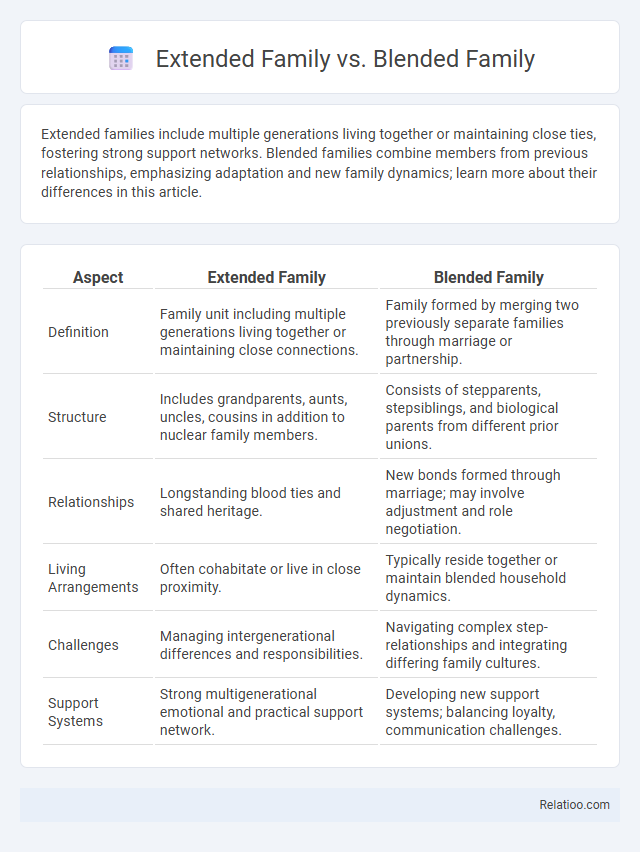Extended families include multiple generations living together or maintaining close ties, fostering strong support networks. Blended families combine members from previous relationships, emphasizing adaptation and new family dynamics; learn more about their differences in this article.
Table of Comparison
| Aspect | Extended Family | Blended Family |
|---|---|---|
| Definition | Family unit including multiple generations living together or maintaining close connections. | Family formed by merging two previously separate families through marriage or partnership. |
| Structure | Includes grandparents, aunts, uncles, cousins in addition to nuclear family members. | Consists of stepparents, stepsiblings, and biological parents from different prior unions. |
| Relationships | Longstanding blood ties and shared heritage. | New bonds formed through marriage; may involve adjustment and role negotiation. |
| Living Arrangements | Often cohabitate or live in close proximity. | Typically reside together or maintain blended household dynamics. |
| Challenges | Managing intergenerational differences and responsibilities. | Navigating complex step-relationships and integrating differing family cultures. |
| Support Systems | Strong multigenerational emotional and practical support network. | Developing new support systems; balancing loyalty, communication challenges. |
Understanding Extended and Blended Families
Understanding extended families involves recognizing a household consisting of multiple generations or relatives beyond the nuclear family, providing strong social support and shared responsibilities. Blended families form when partners bring children from previous relationships, creating new dynamics that require adaptation and communication to foster harmony. Your ability to navigate these family structures depends on appreciating their unique roles and the emotional bonds that connect members across different familial configurations.
Key Differences Between Extended and Blended Families
Extended families consist of multiple generations living together or in close proximity, sharing resources and responsibilities, while blended families form when two separate family units merge due to remarriage or partnership. Key differences include the presence of step-parents and step-siblings in blended families, whereas extended families emphasize blood relations and kinship across generations. Extended families often maintain traditional roles and long-term support systems, contrasting with the dynamic and sometimes transitional nature of blended family relationships.
Cultural Perspectives on Family Structures
Cultural perspectives shape the understanding and value of extended, blended, and nuclear family structures, influencing social roles and support systems within communities. Extended families, prevalent in many Asian, African, and Latin American cultures, emphasize kinship bonds and collective responsibilities, while blended families often reflect modern societal shifts toward remarriage and diverse household compositions. Your cultural background affects expectations and acceptance of each family type, shaping interpersonal dynamics and social integration.
Roles and Responsibilities in Extended Families
Extended families often involve multiple generations living together, where roles and responsibilities are shared among grandparents, parents, aunts, uncles, and cousins, creating a supportive network that aids in childcare, financial stability, and household chores. Blended families, formed through remarriages, require clear communication and flexible roles to accommodate step-parents and step-siblings, promoting unity and stability. Your extended family's shared duties foster emotional support and collectively manage challenges, ensuring that cultural traditions and family values are preserved across generations.
Dynamics and Challenges in Blended Families
Blended families involve merging two separate family units, creating unique dynamics such as adjusting to new parental roles, step-sibling relationships, and co-parenting challenges. These families often face complexities like establishing trust, managing conflicting parenting styles, and navigating loyalty conflicts among members. Your ability to foster open communication and patience is crucial for overcoming these challenges and building a harmonious blended family environment.
Emotional Impact on Children in Both Family Types
Children in extended families often benefit from multiple caregivers, fostering a strong emotional support system that enhances their sense of security and belonging. In blended families, children may face complex emotional adjustments due to shifting family roles and loyalties, which can impact their emotional stability and self-esteem. Understanding these dynamics helps in developing tailored emotional support strategies that promote resilience and positive relationships in both family types.
Legal Considerations for Extended and Blended Families
Legal considerations for extended families often involve inheritance rights, guardianship responsibilities, and estate planning to ensure all relatives are protected under the law. In blended families, navigating child custody, adoption processes, and financial obligations can be more complex due to the presence of step-parents and half-siblings. Understanding these distinctions helps you address legal challenges effectively and secure your family's future.
Support Systems and Resources Available
Extended families offer robust support systems through close-knit ties among multiple generations, providing shared resources such as childcare, financial aid, and emotional support. Blended families integrate diverse support mechanisms by combining resources from multiple parental units, often requiring adaptable communication strategies to balance responsibilities and foster cohesion. In contrast, nuclear families may have limited immediate support but can access external community resources and social networks to supplement their needs.
Conflict Resolution Strategies in Diverse Families
Conflict resolution strategies in extended, blended, and nuclear families require tailored communication approaches that address unique relational dynamics and diverse emotional needs. Extended families benefit from collective decision-making and mediation techniques that leverage strong kinship bonds, while blended families often require negotiation frameworks that acknowledge stepfamily boundaries and foster trust-building among non-biological members. Nuclear families typically emphasize direct communication and problem-solving skills, but integrating cultural sensitivity and emotional intelligence enhances conflict resolution across all diverse family structures.
Adapting to Changing Family Structures
Adapting to changing family structures requires understanding the unique dynamics of extended, blended, and nuclear families. Extended families often rely on multi-generational support networks, while blended families must navigate relationships formed through remarriage, creating new bonds and roles. Your ability to embrace flexibility and open communication is key to fostering harmony across these evolving family types.

Infographic: Extended Family vs Blended Family
 relatioo.com
relatioo.com